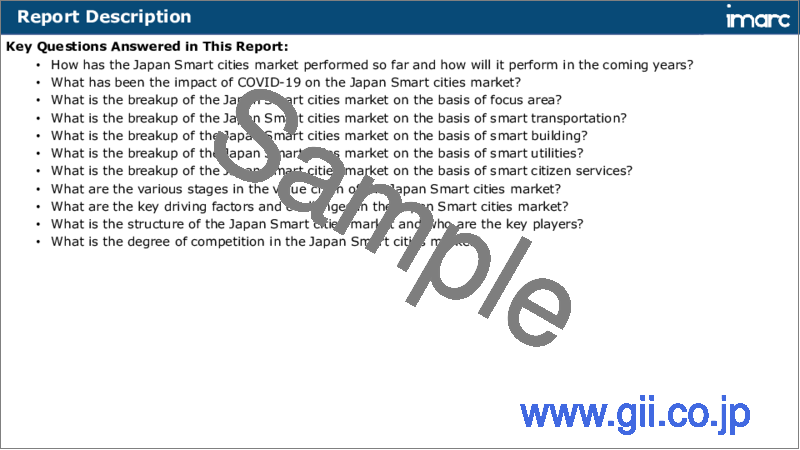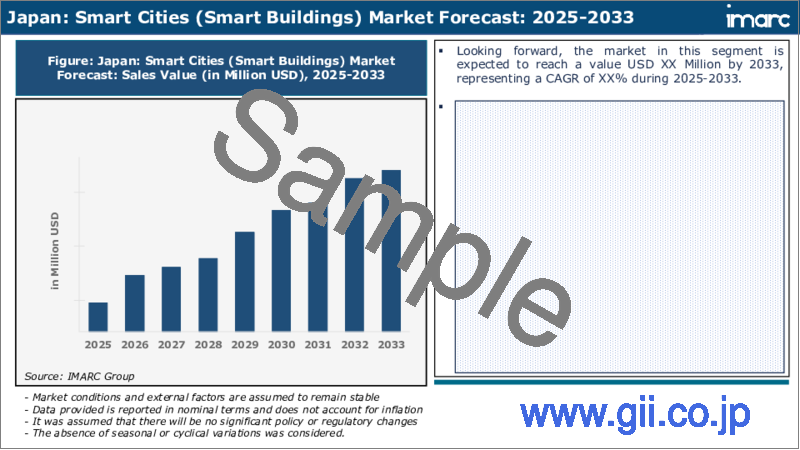|
|
市場調査レポート
商品コード
1609646
日本のスマートシティ市場レポート:重点分野別、スマート交通、スマートビル、スマートユーティリティ、スマート市民サービス、地域別、2025年~2033年Japan Smart Cities Market Report by Focus Area, Smart Transportation, Smart Buildings, Smart Utilities, Smart Citizen Services, and Region 2025-2033 |
||||||
カスタマイズ可能
|
|||||||
| 日本のスマートシティ市場レポート:重点分野別、スマート交通、スマートビル、スマートユーティリティ、スマート市民サービス、地域別、2025年~2033年 |
|
出版日: 2024年12月05日
発行: IMARC
ページ情報: 英文 116 Pages
納期: 5~7営業日
|
全表示
- 概要
- 目次
日本のスマートシティの市場規模は2024年に841億米ドルに達しました。IMARC Groupは、2025年から2033年にかけての成長率(CAGR)は14.6%で、2033年には2,866億米ドルに達すると予測しています。環境の持続可能性への取り組みの増加、急速な都市化活動、最近の技術進歩、日本政府による支援的な政策と規制の賦課、公共の安全とセキュリティの強化への重点の高まりは、市場を牽引する主な要因のいくつかです。
本レポートで扱う主な質問
- 日本のスマートシティ市場はこれまでどのような実績を上げてきたか?
- COVID-19が日本のスマートシティ市場に与えた影響は?
- 日本のスマートシティ市場の重点分野別の内訳は?
- 日本のスマートシティ市場のスマート交通別の内訳は?
- 日本のスマートシティ市場のスマートビルでの内訳は?
- 日本のスマートシティ市場のスマートユーティリティ別の内訳は?
- 日本のスマートシティ市場のスマート市民サービス別の内訳は?
- 日本のスマートシティ市場のバリューチェーンにはどのような段階がありますか?
- 日本のスマートシティ市場の主な促進要因と課題は何か?
- 日本のスマートシティ市場の構造と主要プレーヤーは?
- 日本のスマートシティ市場の競合の程度は?
目次
第1章 序文
第2章 調査範囲と調査手法
- 調査の目的
- ステークホルダー
- データソース
- 市場推定
- 調査手法
第3章 エグゼクティブサマリー
第4章 日本のスマートシティ市場- イントロダクション
- 概要
- 市場力学
- 業界動向
- 競合情報
第5章 日本のスマートシティ市場情勢
- 過去および現在の市場動向(2019年~2024年)
- 市場予測(2025-2033)
第6章 日本のスマートシティ市場- 重点分野別の内訳
- スマート交通
- スマートビルディング
- スマートユーティリティ
- スマート市民サービス
第7章 日本のスマートシティ市場- スマート交通別の内訳
- スマートチケット
- 交通管理システム
- 旅客情報管理システム
- 貨物情報システム
- コネクテッドビークル
- その他
第8章 日本のスマートシティ市場- スマートビル別の内訳
- 建物エネルギーの最適化
- 緊急管理システム
- 駐車場管理システム
- その他
第9章 日本のスマートシティ市場- スマートユーティリティ別の内訳
- 高度計測インフラ
- 流通管理システム
- 変電所自動化
- その他
第10章 日本のスマートシティ市場- スマート市民サービス別の内訳
- スマート教育
- スマートヘルスケア
- スマート公共安全
- スマート街路照明
- その他
第11章 日本のスマートシティ市場- 競合情勢
- 概要
- 市場構造
- 市場プレーヤーのポジショニング
- 主要成功戦略
- 競合ダッシュボード
- 企業評価象限
第12章 主要企業のプロファイル
第13章 日本のスマートシティ市場- 業界分析
- 促進要因・抑制要因・機会
- ポーターのファイブフォース分析
- バリューチェーン分析
第14章 付録
The Japan smart cities market size reached USD 84.1 Billion in 2024. Looking forward, IMARC Group expects the market to reach USD 286.6 Billion by 2033, exhibiting a growth rate (CAGR) of 14.6% during 2025-2033. The increasing commitment to environmental sustainability, rapid urbanization activities, recent technological advancements, imposition of supportive policies and regulations by the Government of Japan, and growing emphasis on enhancing public safety and security represent some of the key factors driving the market.
Smart cities refer to urban areas that leverage digital technology, information, and communication systems to enhance the quality of life, efficiency of services, and economic prosperity. They comprise several components, such as intelligent transportation systems, smart energy grids, advanced sensors, and integrated communication networks. They offer numerous features, including real-time monitoring, analytics, automation, and seamless connectivity. Smart cities applications range from traffic management, waste control, energy efficiency, water supply management, healthcare services, education systems, crime prevention, disaster management, building management, public transportation, governance, tourism, environmental monitoring, agriculture, and e-governance. It aids in improving sustainability, conserving energy, reducing pollution, enhancing public safety, increasing accessibility, augmenting healthcare, providing higher education quality, and optimizing public services. Smart cities also facilitate rapid infrastructure development, economic growth, social integration, technological innovation, intelligent mobility, citizen empowerment, enhanced quality of life, and community development. They also provide several advantages, such as reduced costs, streamlined operations, agility in response to urban challenges, integrated management, adaptability to changing needs, strengthened resilience, collaboration between sectors, transparent governance, environmental stewardship, improved planning, better social cohesion, inclusiveness, and increased public engagement.
Japan Smart Cities Market Trends:
The Japan's commitment to environmental sustainability is facilitating the demand for smart cities, as they leverage green technologies to reduce carbon emissions, lower pollution levels, and minimize energy consumption. Additionally, the rapid urbanization in Japan's metropolitan areas, which necessitates efficient management of resources, including transportation, utilities, and public spaces, is boosting the market growth. Furthermore, the recent advancements in technology, including the Internet of Things (IoT) and artificial intelligence (AI), which facilitate the smart management of infrastructure, traffic, public safety and surveillance, healthcare, urban planning, and public services, are propelling the market growth. Besides this, the imposition of supportive policies and regulations by the Government of Japan to accelerate the development of smart cities to preserve the environment, improve public safety, and boost economic growth is strengthening the market growth. Apart from this, the growing emphasis on enhancing public safety and security through intelligent systems as they offer round-the-clock services, increase transparency, and eliminate human errors is acting as another growth-inducing factor. Moreover, the rising consumer awareness regarding energy efficiency and environmental conservation encouraging the adoption of smart city initiatives is catalyzing the market growth. In addition, the presence of an aging infrastructure across Japan, which demands modernization, is fueling the market growth. Along with this, the rising focus on improving transportation and traffic management to facilitate easy commutes and save time is positively impacting the market growth.
Japan Smart Cities Market Segmentation:
Focus Area Insights:
- Smart Transportation
- Smart Buildings
- Smart Utilities
- Smart Citizen Services
Smart Transportation Insights:
- Smart Ticketing
- Traffic Management System
- Passenger Information Management System
- Freight Information System
- Connected Vehicles
- Others
Smart Buildings Insights:
- Building Energy Optimization
- Emergency Management System
- Parking Management System
- Others
Smart Utilities Insights:
- Advanced Metering Infrastructure
- Distribution Management System
- Substation Automation
- Others
Smart Citizen Services Insights:
- Smart Education
- Smart Healthcare
- Smart Public Safety
- Smart Street Lighting
- Others
Competitive Landscape:
- The report has also provided a comprehensive analysis of the competitive landscape in the market. Competitive analysis such as market structure, key player positioning, top winning strategies, competitive dashboard, and company evaluation quadrant has been covered in the report. Also, detailed profiles of all major companies have been provided.
Key Questions Answered in This Report:
- How has the Japan Smart cities market performed so far and how will it perform in the coming years?
- What has been the impact of COVID-19 on the Japan Smart cities market?
- What is the breakup of the Japan Smart cities market on the basis of focus area?
- What is the breakup of the Japan Smart cities market on the basis of smart transportation?
- What is the breakup of the Japan Smart cities market on the basis of smart building?
- What is the breakup of the Japan Smart cities market on the basis of smart utilities?
- What is the breakup of the Japan Smart cities market on the basis of smart citizen services?
- What are the various stages in the value chain of the Japan Smart cities market?
- What are the key driving factors and challenges in the Japan Smart cities market?
- What is the structure of the Japan Smart cities market and who are the key players?
- What is the degree of competition in the Japan Smart cities market?
Table of Contents
1 Preface
2 Scope and Methodology
- 2.1 Objectives of the Study
- 2.2 Stakeholders
- 2.3 Data Sources
- 2.3.1 Primary Sources
- 2.3.2 Secondary Sources
- 2.4 Market Estimation
- 2.4.1 Bottom-Up Approach
- 2.4.2 Top-Down Approach
- 2.5 Forecasting Methodology
3 Executive Summary
4 Japan Smart Cities Market - Introduction
- 4.1 Overview
- 4.2 Market Dynamics
- 4.3 Industry Trends
- 4.4 Competitive Intelligence
5 Japan Smart Cities Market Landscape
- 5.1 Historical and Current Market Trends (2019-2024)
- 5.2 Market Forecast (2025-2033)
6 Japan Smart Cities Market - Breakup by Focus Area
- 6.1 Smart Transportation
- 6.1.1 Overview
- 6.1.2 Historical and Current Market Trends (2019-2024)
- 6.1.3 Market Forecast (2025-2033)
- 6.2 Smart Buildings
- 6.2.1 Overview
- 6.2.2 Historical and Current Market Trends (2019-2024)
- 6.2.3 Market Forecast (2025-2033)
- 6.3 Smart Utilities
- 6.3.1 Overview
- 6.3.2 Historical and Current Market Trends (2019-2024)
- 6.3.3 Market Forecast (2025-2033)
- 6.4 Smart Citizen Services
- 6.4.1 Overview
- 6.4.2 Historical and Current Market Trends (2019-2024)
- 6.4.3 Market Forecast (2025-2033)
7 Japan Smart Cities Market - Breakup by Smart Transportation
- 7.1 Smart Ticketing
- 7.1.1 Overview
- 7.1.2 Historical and Current Market Trends (2019-2024)
- 7.1.3 Market Forecast (2025-2033)
- 7.2 Traffic Management System
- 7.2.1 Overview
- 7.2.2 Historical and Current Market Trends (2019-2024)
- 7.2.3 Market Forecast (2025-2033)
- 7.3 Passenger Information Management System
- 7.3.1 Overview
- 7.3.2 Historical and Current Market Trends (2019-2024)
- 7.3.3 Market Forecast (2025-2033)
- 7.4 Freight Information System
- 7.4.1 Overview
- 7.4.2 Historical and Current Market Trends (2019-2024)
- 7.4.3 Market Forecast (2025-2033)
- 7.5 Connected Vehicles
- 7.5.1 Overview
- 7.5.2 Historical and Current Market Trends (2019-2024)
- 7.5.3 Market Forecast (2025-2033)
- 7.6 Others
- 7.6.1 Historical and Current Market Trends (2019-2024)
- 7.6.2 Market Forecast (2025-2033)
8 Japan Smart Cities Market - Breakup by Smart Buildings
- 8.1 Building Energy Optimization
- 8.1.1 Overview
- 8.1.2 Historical and Current Market Trends (2019-2024)
- 8.1.3 Market Forecast (2025-2033)
- 8.2 Emergency Management System
- 8.2.1 Overview
- 8.2.2 Historical and Current Market Trends (2019-2024)
- 8.2.3 Market Forecast (2025-2033)
- 8.3 Parking Management System
- 8.3.1 Overview
- 8.3.2 Historical and Current Market Trends (2019-2024)
- 8.3.3 Market Forecast (2025-2033)
- 8.4 Others
- 8.4.1 Historical and Current Market Trends (2019-2024)
- 8.4.2 Market Forecast (2025-2033)
9 Japan Smart Cities Market - Breakup by Smart Utilities
- 9.1 Advanced Metering Infrastructure
- 9.1.1 Overview
- 9.1.2 Historical and Current Market Trends (2019-2024)
- 9.1.3 Market Forecast (2025-2033)
- 9.2 Distribution Management System
- 9.2.1 Overview
- 9.2.2 Historical and Current Market Trends (2019-2024)
- 9.2.3 Market Forecast (2025-2033)
- 9.3 Substation Automation
- 9.3.1 Overview
- 9.3.2 Historical and Current Market Trends (2019-2024)
- 9.3.3 Market Forecast (2025-2033)
- 9.4 Others
- 9.4.1 Historical and Current Market Trends (2019-2024)
- 9.4.2 Market Forecast (2025-2033)
10 Japan Smart Cities Market - Breakup by Smart Citizen Services
- 10.1 Smart Education
- 10.1.1 Overview
- 10.1.2 Historical and Current Market Trends (2019-2024)
- 10.1.3 Market Forecast (2025-2033)
- 10.2 Smart Healthcare
- 10.2.1 Overview
- 10.2.2 Historical and Current Market Trends (2019-2024)
- 10.2.3 Market Forecast (2025-2033)
- 10.3 Smart Public Safety
- 10.3.1 Overview
- 10.3.2 Historical and Current Market Trends (2019-2024)
- 10.3.3 Market Forecast (2025-2033)
- 10.4 Smart Street Lighting
- 10.4.1 Overview
- 10.4.2 Historical and Current Market Trends (2019-2024)
- 10.4.3 Market Forecast (2025-2033)
- 10.5 Others
- 10.5.1 Historical and Current Market Trends (2019-2024)
- 10.5.2 Market Forecast (2025-2033)
11 Japan Smart Cities Market - Competitive Landscape
- 11.1 Overview
- 11.2 Market Structure
- 11.3 Market Player Positioning
- 11.4 Top Winning Strategies
- 11.5 Competitive Dashboard
- 11.6 Company Evaluation Quadrant
12 Profiles of Key Players
- 12.1 Company A
- 12.1.1 Business Overview
- 12.1.2 Product Portfolio
- 12.1.3 Business Strategies
- 12.1.4 SWOT Analysis
- 12.1.5 Major News and Events
- 12.2 Company B
- 12.2.1 Business Overview
- 12.2.2 Product Portfolio
- 12.2.3 Business Strategies
- 12.2.4 SWOT Analysis
- 12.2.5 Major News and Events
- 12.3 Company C
- 12.3.1 Business Overview
- 12.3.2 Product Portfolio
- 12.3.3 Business Strategies
- 12.3.4 SWOT Analysis
- 12.3.5 Major News and Events
- 12.4 Company D
- 12.4.1 Business Overview
- 12.4.2 Product Portfolio
- 12.4.3 Business Strategies
- 12.4.4 SWOT Analysis
- 12.4.5 Major News and Events
- 12.5 Company E
- 12.5.1 Business Overview
- 12.5.2 Product Portfolio
- 12.5.3 Business Strategies
- 12.5.4 SWOT Analysis
- 12.5.5 Major News and Events
13 Japan Smart Cities Market - Industry Analysis
- 13.1 Drivers, Restraints, and Opportunities
- 13.1.1 Overview
- 13.1.2 Drivers
- 13.1.3 Restraints
- 13.1.4 Opportunities
- 13.2 Porters Five Forces Analysis
- 13.2.1 Overview
- 13.2.2 Bargaining Power of Buyers
- 13.2.3 Bargaining Power of Suppliers
- 13.2.4 Degree of Competition
- 13.2.5 Threat of New Entrants
- 13.2.6 Threat of Substitutes
- 13.3 Value Chain Analysis





